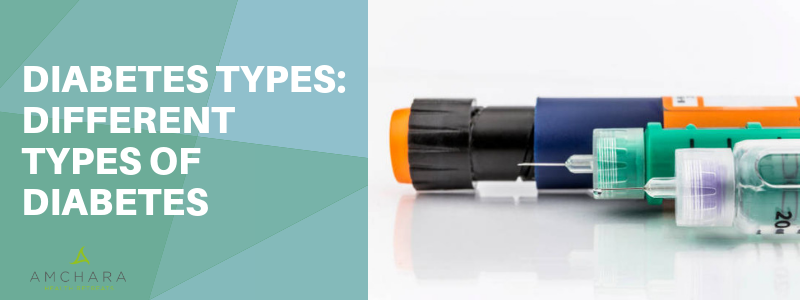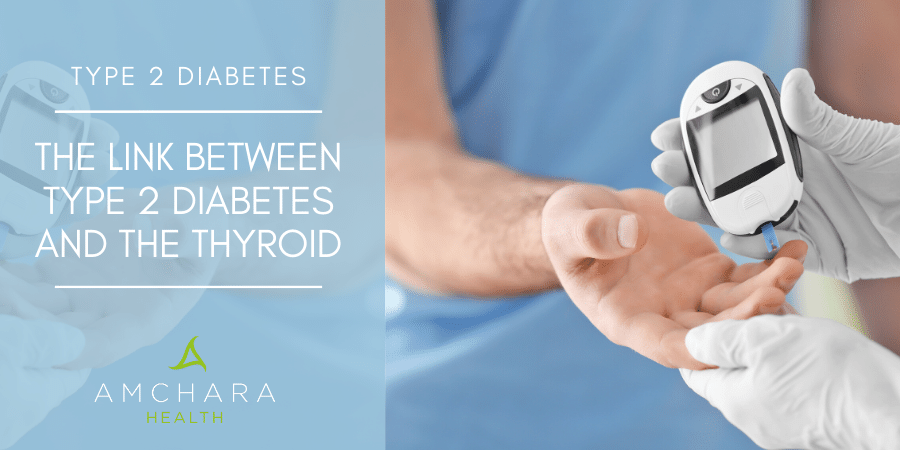Topics Covered in this article:
What can be done about Diabetes?
In an ideal world, the aim would be to prevent diabetes developing in the first place, but before you can take steps to ensure this happens, it's important to understand what diabetes is, the effect it has on your body and how varying factors impact your blood sugar control.
In this article, we discuss the different forms of diabetes, the symptoms to expect, the risk factors and the consequences to your health.
Additionally, learn how Amchara could help to reduce your symptoms, avoid complications and potentially prevent the risk of developing diabetes in the first place.
Types of diabetes
There are three major types of diabetes, Type 1, Type 2 and gestational diabetes.
They all cause blood glucose levels to be abnormally high but in different ways.
Other types of diabetes are pre-diabetes and secondary diabetes.
-
Pre-diabetes
In pre-diabetes blood glucose levels are higher than normal but not yet at levels that would be defined as diabetes. Pre-diabetes often leads to Type 2 diabetes and usually occurs within 10 years.
Reactive hypoglycaemia is thought by many to be a pre-diabetic condition and happens due to a diet too high in refined carbohydrates, high on the glycaemic index. Being pre-diabetic can raise your risk for heart disease and stroke.
-
Type 1 diabetes
Also called juvenile-onset diabetes or insulin-dependent diabetes (IDDM). It has a rapid onset, with fatigue, weight loss and extreme thirst. It is considered an autoimmune condition whereby the body's immune system destroys the pancreatic cells needed to produce insulin.
This results in an insufficient supply of insulin or no insulin at all. People with Type 1 diabetes must take insulin daily to survive.
-
Type 2 diabetes
This is by far the most common type of disease accounting for approximately 90% of all diabetes in the UK. It has been coined 'adult onset diabetes' as it usually affects people older than 40 and more women than men, however it is now found commonly in obese teenagers due to lifestyle and is rising at an alarming rate.
According to a large-scale UK study, children with a BMI that exceeds the normal range are 4 times at risk of developing Type 2 diabetes (3).
In Type 2 diabetes the cells in the body are not receptive to insulin, so a greater amount of insulin is needed to keep blood glucose levels within a normal range.
The pancreas produces extra insulin to compensate for the high glucose levels, but eventually becomes partially exhausted, producing less and less insulin.
Symptoms of Type 2 diabetes take much longer to become apparent unlike with Type 1.
Initial symptoms may include:
- feeling tired or unwell
- frequent urination – particularly at night
- unusual thirst
- excessive sweating
- increased hunger
- weight loss
- blurred vision
- frequent infections
- slow healing wounds and sores
- tingling/numbness in hands or feet
- sexual dysfunction
-
Gestational diabetes
This occurs during pregnancy, which is due to changes in hormone levels. It is diagnosed more often in obese or older women and some ethnic groups, as well as in women who have previously had large babies or have a history of glucose intolerance.
It must be treated in order to keep the mother's blood glucose normal to avoid complications in the baby.
-
Type 1.5 diabetes (LADA)
A percentage of those diagnosed with Type 2 diabetes have actually been found to have latent autoimmune diabetes of adults (LADA), which has aspects of both Type 1 and Type 2 diabetes.
In these individuals the immune system attacks the pancreatic cells affecting insulin production, but they may also develop insulin resistance.
It can be managed with diet and exercise initially but may require insulin therapy later.
-
Secondary diabetes
Several forms exist, caused by pregnancy, hormonal or genetic problems, drugs, chemicals or conditions such as pancreatic disease.
What are the health complications of Diabetes?
Individuals diagnosed with diabetes have an increased risk of developing a range of serious health complications, particularly if their diabetes is poorly controlled.
The chronic complications of diabetes could affect virtually all systems of the body.
-
Neuropathy
Neuropathy can cause damage to the nerves that send messages to and from the muscles, skin, blood vessels, brain and spinal cord. It also affects the nerves that control involuntary activities in the body such as the stomach and heart.
Symptoms of neuropathy include:
- Tingling and numbness in the hands, legs or feet
- Muscle weakness
- Intermittent diarrhoea or constipation
- Failure to feel pain and sensations
- Inability to pass urine properly
- Erectile dysfunction
- Nausea
- Vomiting
- Bloating
- Weight loss
- Dizziness
- Visual impairment
- Sweating disturbances
-
Cardiovascular complications
Diabetes and heart disease are, unfortunately, intimately linked. Individuals with Type 2 diabetes often have high blood pressure, low HDL ('good') cholesterol and raised triglyceride levels.
High blood pressure increases the risk of diabetic eye and kidney damage, as well as circulatory problems and heart disease.
Regular exercise, eating a low-fat and low-salt diet, and reducing alcohol intake can all help to lower blood pressure.
According to statistics, heart disease is a leading cause of death and occurs in around 65% of people with diabetes (6).
The risk is 2-4 times higher amongst individuals with diabetes than those without it. In addition to this the risk of stroke is increased 2-4 times.
Poorly controlled blood glucose levels affect the lining of the body's arterial walls, which increases the probability of furring up of the vessels, leading to narrowing (atherosclerosis).
The risks for cardiovascular disease increase if the diabetic individual smokes is obese, or is physically inactive.
-
Blindness
Persistent high levels of blood glucose can damage blood vessels in the eyes which affects the blood supply to the retina eventually causing loss of vision.
Smoking increases the risk of these complications. Diabetes is a leading cause of blindness in adults aged 20-74 years, however catching this disease early and treating it can prevent 90% of blindness (7).
Other eye diseases associated with diabetes are glaucoma and cataracts.
Glycosylation of proteins within the eyes may contribute to cataracts.
-
Foot problems
Lack of sensation and poor circulation can increase the risk of individuals with diabetes developing problems like foot ulcers and infections.
At worse if left untreated it could lead to amputations. According to Diabetes UK, there were 26,378 lower limb amputations related to diabetes in England from 2014 to 2017 (8).
-
Mental health issues
Research has identified that there is a risk of cognitive dysfunction and depression amongst elderly diabetics where there is poor diabetes control.
This is likely due in part to the elderly being unable to follow complicated regimes and living alone without anyone to monitor their health over extended periods of time.
-
Quality of life
Diabetes may affect many areas of life and can be stressful; however, managing it well can have a hugely beneficial impact on the quality of life, especially if steps are taken to reduce factors that may be contributing to the disease.
-
Disabilities
People with diabetes are at an increased risk of developing disabilities due to complications. Globally, diabetes is a leading cause of kidney failure, cardiovascular disease, blindness and lower limb amputation.
-
Obesity
Obesity is commonly recognised as one of the main risk factors for the development of diabetes. Up to 90% of Type 2 diabetes appears to be due to weight gain and obesity.
There is also increasing evidence that waist measurement is another risk factor.
Several studies have shown that weight loss improves glycaemic control and leads to remission of diabetes in some individuals.
Very low energy diets have been found to decrease fasting glucose values by 50% within as little as two weeks and losing just 10% of initial body weight dramatically improves blood pressure, reduces lipids and improves glycaemic control (9).
What are the risk factors for Diabetes?
Although heredity is a risk factor in determining the risk of Type 2 diabetes, environment and lifestyle have a significant influence and should not be underestimated.
Increased consumption of nutrient-poor foods and improvements in transport are factors that have contributed to this pandemic.
Technology has advanced significantly replacing the need for manual labour with mechanical processes and increasingly sedentary lifestyles have frequently been cited as a risk factor for diabetes.
It should be noted that physical activity has been shown to increase tissue sensitivity to insulin, improving blood glucose control.
Scientific evidence and population studies clearly demonstrate that factors related to physical activity and diet have a substantial impact on the development of diabetes.
Other research suggests there may also be a link between low birth weight and developing diabetes later in life.
Risks for Type 1 diabetes:
- Viruses – some experts believe that enteroviruses that cause German measles and mumps may trigger Type 1 diabetes.
- Foods – research evidence suggests that early exposure to cow's milk or foods containing wheat increases the life-time risk of developing Type 1 diabetes in children already at risk.
- Genes – Type 1 runs in families.
Risks for Type 2 diabetes:
- Smoking – can elevate blood glucose concentration and may increase resistance to insulin (9)(13).
- Being overweight or obese – is the single most important predictor. 60-90% of Type 2 diabetes is related to obesity or weight gain. Diabetes is closely associated with obesity (7).
A large proportion of newly diagnosed older diabetics are overweight.
Dietary control with a high-unrefined carbohydrate, low saturated fat and low sugar diet is vital to achieve an ideal weight.
- Physical inactivity – substantially increases the risk of diabetes (14). Exercise increases tissue sensitivity to insulin.
- Increased waist circumference – increases risk of diabetes (15).
- A diet high in saturated fats – saturated fats decrease insulin sensitivity (12). Many people with Type 2 diabetes have unhealthy levels of blood fats. Too much of the wrong type of fat in the blood increases the risk of heart disease and circulation problems.
- A diet low in whole grains – increases risk of diabetes.
- A diet with a high glycaemic load – increases risk of diabetes.
- A diet low in fibre, particularly cereal fibre – fibre delays the absorption of carbohydrates after eating and reduces the insulin response to other dietary carbohydrates.
- Increasing age – more likely to be less active and have high BP and high cholesterol.
- Polycystic ovary syndrome – associated with diabetes.
- Race – Afro Americans, Asian Americans, Hispanics and Native Americans are at greater risk of diabetes.
- Higher consumption of sugar sweetened beverages – consumption has risen globally and is associated with weight gain and obesity (10).
- Low grade systemic inflammation – may have an indirect influence on insulin secretion and resistance.
Managing Diabetes with a Personalised Health Approach
Functional medicine uses a science based integrative approach to healthcare which deals with illness and promotes good health by examining the unique aspects of each person.
Practitioners aim to work together with patients to maximise good health by focusing on and addressing underlying causes of disease, rather than simply treating symptoms, with an awareness that one condition may have many causes and likewise one cause may lead to several different conditions.
Understanding the causes of the disease involves gaining a detailed understanding of each individual's' genetic, biochemical and lifestyle factors, and using this knowledge to tailor a programme specifically to regain physiological, structural and psychological balance.
Nutrition counselling is patient centred, sensitive to an individual's needs, willingness to change and ability to make changes.
Functional medicine aims to target the specific manifestation of ill health in each individual.
Following a comprehensive consultation, which may include functional tests, a functional health practitioner will employ a multi-faceted approach to treatment that includes:
- A personalised diet plan – what you eat directly affects your blood sugar and insulin levels.
- A personalised exercise plan – exercise can reduce blood sugar levels and insulin demands dramatically.
- Stress management – stress has a big impact on blood sugar levels and insulin.
- Reduce toxins – toxic substances cause inflammation and increase insulin resistance.
- Specifically targeted supplementation – key nutrients may be lacking in individuals with diabetes.
- Emotional support – other complementary disciplines may be employed to support patients through treatment e.g. neuro-linguistic programming (NLP), meditation, yoga, acupuncture etc.
Dietary & Lifestyle tips: Putting theory into practice
As part of a healthy eating plan, it is advisable to cut down on sugar because it has little nutritional value and does little to sustainably satisfy the appetite.
Researchers have made considerable progress in identifying several lifestyle and dietary factors associated with diabetes.
Studies show that a diet high in whole grain cereal fibre and polyunsaturated or monounsaturated fat and low in saturated fats, trans fats and glycaemic load, combined with moderate to high intensity daily exercise for at least 30 minutes a day may help to prevent diabetes and manage complications (11)(12).
Additionally, recent studies have reported that a 'moderate' intake of alcohol is also associated with improved glycaemic control in people with diabetes, (no more than 4fl oz daily) (22).
However, there are some medical conditions where alcohol is contraindicated including hypertension, hypertriglyceridemia, some neuropathies and retinopathy. Alcohol should also be avoided during pregnancy.
Other research has identified that low fat dairy foods, green leafy vegetables and coffee are associated with reduced risk of Type 2 diabetes. Additionally, a low intake of saturated fat is known to have a protective effect (11).
Less favourable food choices include red meats, processed meat products and fried potatoes which are associated with increased risk of Type 2 diabetes.
Essential Nutrients
Some key nutrients which may reduce symptoms and complications in individuals with blood sugar issues include:
- Chromium – helps make cells more receptive to insulin and helps to lower blood sugar levels. There is strong evidence that chromium picolinate improves glycaemic control (16) (17).
- Alpha-lipoic acid (ALA) – is a key nutrient for producing energy from sugar. It has anti-inflammatory and anti-oxidant properties and helps to reduce insulin resistance (17).
- Magnesium – stress depletes magnesium and individuals with diabetes tend to utilise magnesium faster than non-diabetics. It also helps to produce energy and maintain normal blood pressure. Observational data suggest that magnesium supplementation may decrease the risk of Type 2 diabetes.
- Zinc – excess inflammation depletes zinc levels. Many diabetics are low in zinc due to the inflammatory nature of diabetes.
- B vitamins – diabetic medications can deplete B vitamins.
- Vitamin D & Calcium – Epidemiological evidence suggests that high intakes of vitamin D and calcium may reduce risk (20).
- Ginseng – Ginseng can cause hypoglycaemia, perhaps through activity similar to insulin or by altering hepatic glucose metabolism (19).
- Cinnamon – has been used for thousands of years to treat diabetes. Evidence suggests that it can lower blood glucose levels (18).
- Antioxidants – A range of antioxidants may benefit an individual with diabetes because many of the consequences of diabetes are due to oxidative stress mechanisms in the body. Studies have found that antioxidants have proven beneficial in those with sight threatening cataracts.
Many of these nutrients can be increased by making healthy food choices, however for some people there may be dietary restrictions, intolerances, food preferences or issues surrounding access to healthy foods. In these cases, supplementation may be advisable.
Fasting and diabetes – the benefits
There are many different types of fasting which can be distinguished by intensity, duration or frequency.
Evidence suggests that fasting offers a range of healing benefits, although it is not suitable for everyone.
As a rule, fasting should not be recommended to children, pregnant or nursing mothers or individuals with eating disorders.
In terms of weight loss success, fasting that involves very low-calorie diets is believed to be more effective than other strategies for reducing weight for people with diabetes.
Research has found that diets providing 800 calories daily produce substantial weight loss and rapid improvements in glycaemia and lipemia in individuals with Type 2 diabetes.
Furthermore, a small trial carried out by Newcastle University in 2011 identified that subjects on an 800 calorie a day diet over 8 weeks were able to come off their medication and achieve remission from diabetes (21).
In a later study, 40% of participants following a similar diet over a similar time period were found to achieve the same benefits plus they were able to maintain remission from Type 2 diabetes 6 months after completing the trial.
Another study found that calorie restriction brought about a marked improvement in glycaemic control that matched the effects of Roux-en-Y gastric bypass surgery (RYGB) (9).
The researchers concluded that a very low-calorie diet improves insulin sensitivity and pancreatic beta cell function equally as well as RYGB in the short term.
However, fasting or restricted calorie diets should not be undertaken by individuals with Type 1 diabetes.
There is a chance that blood glucose levels may elevate to dangerously high levels and result in a buildup of ketones which could lead to a serious condition called ketoacidosis.
How Amchara Can Help
Whether you've already been diagnosed with Type 2 diabetes or you suspect you may be pre-diabetic, a trip to an Amchara health retreat could help to reduce your risk or better manage your symptoms.
You could opt for a supervised fast, which evidence suggests brings really positive results, or you can take a more moderate approach and ease yourself gently into a healthier nutrition plan and lifestyle, under the guidance of one of our expert functional medicine practitioners.
Contact us today for more information
Include the image used at the bottom of the Balance your hormones programme – 'We can support you in one of two ways'
See what some of our clients have had to say about their own personal Amchara retreat successes…
Did you find this article useful?
We are dedicated to providing insightful information on key aspects of health – all orientated towards the Personalised Health approach.
Jacqueline Newson BSc (Hons) Nutritional Therapy
READ THIS NEXT:







